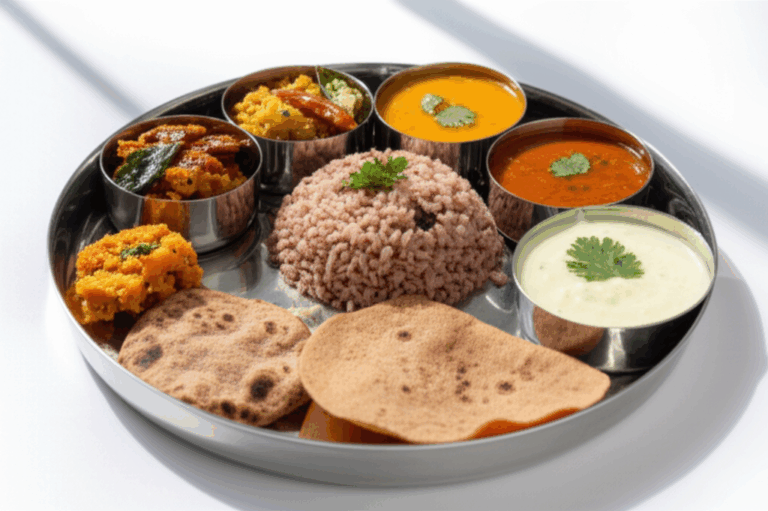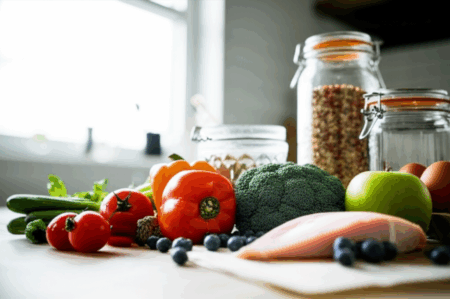South Indian vegetarian cuisine is often celebrated for its vibrant flavors and diverse range of dishes. But can these meals truly be considered healthy? According to fitness coach Raj Ganpath, a simple South Indian vegetarian meal can indeed be “very healthy when balanced right.” Let’s explore the nutritional aspects of this cuisine and understand how to create balanced and nutritious South Indian vegetarian meals.
Decoding the South Indian Vegetarian Diet
South Indian cuisine is characterized by its use of rice, lentils, legumes, vegetables, coconut, and an array of spices. Popular dishes include:
- Idli and Dosa: Fermented rice and lentil-based dishes, often served with sambar and chutney.
- Sambar and Rasam: Lentil-based vegetable stews seasoned with tamarind and spices.
- Poriyal and Kootu: Vegetable stir-fries and stews, often incorporating coconut and lentils.
- Upma and Pongal: Savory dishes made from semolina or rice.
- Avial: A mixed vegetable curry with coconut, yogurt, and spices.
The Building Blocks of a Healthy South Indian Meal
To create a balanced and healthy South Indian vegetarian meal, it’s essential to include the following components:
- Protein: Lentils, legumes, and dairy products (like yogurt and buttermilk) are excellent sources of plant-based protein.
- Carbohydrates: Rice, millets, and other grains provide energy. Opt for brown rice or millets for added fiber.
- Healthy Fats: Coconut, nuts, and seeds offer essential fatty acids.
- Fiber: Vegetables, lentils, and whole grains contribute to digestive health and satiety.
- Vitamins and Minerals: A variety of colorful vegetables and spices ensure a wide range of micronutrients.
The Nutritional Powerhouse: Why South Indian Vegetarian Food Works
South Indian vegetarian meals offer a plethora of health benefits when prepared and consumed thoughtfully.
1. Rich in Essential Nutrients
South Indian dishes are crafted from an array of wholesome ingredients, such as lentils, vegetables, and spices, each offering a wealth of essential nutrients. From protein-packed lentils to antioxidant-rich spices like turmeric and cumin, every component of a South Indian meal contributes to our nutritional needs, supporting overall health and vitality.
Many dishes feature an array of vegetables, which are a great source of vitamins such as Vitamin A, Vitamin C, and folate. For example, avial, a vegetable dish made with a variety of vegetables like carrots, beans, and drumsticks, is a great source of vitamins and minerals. These vitamins are crucial for maintaining healthy skin, boosting the immune system, and promoting cell repair and regeneration.
2. High in Fiber
One of the standout health benefits of South Indian vegetarian meals is their high fiber content. Many traditional South Indian dishes, such as sambar, rasam, and kootu, are made with lentils, beans, and vegetables—foods naturally rich in fiber. Fiber plays a crucial role in maintaining digestive health, helping to regulate bowel movements, prevent constipation, and reduce the risk of digestive disorders like irritable bowel syndrome. Dishes like idli and dosa, made from fermented rice and lentils, are also packed with fiber.
3. Plant-Based Protein
South Indian vegetarian meals are often protein-rich, thanks to the liberal use of lentils, legumes, and beans. Sambar, for example, is packed with protein from the lentils and other legumes like pigeon peas. Similarly, dishes like moong dal, chana masala, and kootu provide a substantial amount of protein, which is essential for muscle repair, immune function, and overall body health. Plant-based proteins from lentils, beans, and chickpeas are not only more digestible than animal proteins, but they also come with added health benefits.
4. Supports Digestion
South Indian vegetarian meals, particularly those made with fermented ingredients like idli and dosa, are excellent for gut health. The fermentation process enhances the digestibility of rice and lentils, breaking down complex starches and increasing the availability of nutrients. Fermented foods are also rich in probiotics, which promote the growth of healthy gut bacteria.
5. Balanced Eating
South Indian cuisine emphasises a balanced approach to eating, incorporating a variety of food groups to ensure a well-rounded diet.
6. Low in Fat
Many South Indian dishes are naturally low in fat, particularly those that are steamed or lightly cooked. For instance, idlis and dosas are steamed or grilled, which reduces the need for added fats. The use of coconut, which is rich in healthy fats, adds flavor and nutrients without contributing to excess calorie intake.
7. Metabolism Boost
Spices like cumin, coriander, and black pepper, commonly used in South Indian dishes, are known to enhance metabolism and aid in digestion. These spices stimulate the secretion of digestive enzymes, promoting efficient nutrient absorption and metabolism. Moreover, the inclusion of protein-rich lentils and fibre-packed vegetables helps keep blood sugar levels stable, preventing spikes and crashes that can disrupt metabolism.
8. Anti-inflammatory Properties
Many spices commonly used in South Indian cooking, such as turmeric, ginger, and garlic, possess potent anti-inflammatory properties.
9. Heart Health
The incorporation of heart-healthy ingredients like lentils, vegetables, and coconut oil makes South Indian cuisine a boon for cardiovascular health.
10. Rich in Vitamins and Minerals
South Indian vegetarian meals are packed with essential vitamins and minerals. Many dishes feature an array of vegetables, which are a great source of vitamins such as Vitamin A, Vitamin C, and folate.
11. Traditional Superfoods
Certain South Indian ingredients has some nutrients in food that are considered superfoods due to their high nutrient density. Moringa, known locally as drumstick, is rich in vitamins A, C, and E, while curry leaves are packed with antioxidants. Incorporating these superfoods can help provide additional health benefits.
Sample Balanced South Indian Vegetarian Meal
Fitness coach Raj Ganpath shared a glimpse of a meal that exemplifies a balanced South Indian vegetarian diet. This meal included:
- Ivy gourd poriyal
- Spinach poriyal
- Tamarind coconut kozhambu/curry
- Dal rice with ghee
- A chocolate protein shake
Let’s break down the nutritional value of each component:
- Ivy Gourd Poriyal: 80 calories, 2g protein, 8g carbs, 5g fat
- Spinach Poriyal: 70 calories, 3g protein, 5g carbs, 5g fat
- Tamarind Coconut Kozhambu/Curry: 150 calories, 2g protein, 5g carbs, 10g fat
- Dal Rice with Ghee: Approximately 300 calories (depending on portion size)
- Chocolate Protein Shake: Provides an additional boost of protein
This combination offers a balance of protein, carbohydrates, healthy fats, and essential micronutrients.
Tips for Making South Indian Meals Healthier
- Opt for Whole Grains: Choose brown rice, millets, or quinoa instead of white rice to increase fiber intake.
- Load Up on Vegetables: Include a variety of colorful vegetables in your meals to boost vitamin and mineral content.
- Control Portion Sizes: Be mindful of portion sizes, especially when it comes to rice and ghee.
- Use Healthy Cooking Methods: Steam, grill, or bake your food instead of frying.
- Limit Oil and Coconut: While coconut is healthy, use it in moderation to avoid excess fat intake.
- Incorporate Fermented Foods: Include idli, dosa, or buttermilk in your diet for gut health.
- Add Protein: Ensure each meal contains a good source of protein, such as lentils, legumes, or dairy products.
- Spice It Up: Use a variety of spices like turmeric, ginger, and cumin for their health benefits.
Quick & Healthy South Indian Recipes for Weight Loss
- Ragi Dosa: Made with finger millet, rich in fiber and minerals.
- Millet Idli: A healthier alternative to rice idli.
- Brown Rice Sambar: A filling and nutritious combination.
- Quinoa Upma: A protein-packed twist on the traditional upma.
- Moong Dal Dosa: A protein-rich and low-carb option.
Sample 7-Day South Indian Meal Plan for Weight Loss
- Day 1: Ragi dosa with coconut chutney (Breakfast), Brown rice with sambar & vegetable stir-fry (Lunch), Buttermilk with flaxseeds (Snack), Moong dal dosa with tomato chutney (Dinner)
- Day 2: Steamed idli with mint chutney (Breakfast), Quinoa upma with mixed vegetables (Lunch), Almonds & green tea (Snack), Millets dosa with curry leaf chutney (Dinner)
- Day 3: Rava upma with coconut garnish (Breakfast), Lentil soup with chapati (Lunch), Sprouts chaat (Snack), Grilled paneer with mixed greens (Dinner)
South Indian Diet for Specific Needs
South Indian Diet for Diabetics
A South Indian diet can be suitable for diabetics with careful planning. Emphasize whole grains, fiber-rich vegetables, and portion control. Avoid excessive rice and sugary sweets. Include foods with a low glycemic index to manage blood sugar levels effectively.
- Foods to eat often: Steamed idlis, Dosa with little oil, Upma made with cracked wheat.
- Liquids to drink often: Thin buttermilk, Unsweetened lime juice, Plain water.
- Foods to eat in moderation: Cereals such as rice, jowar, bajra, and ragi.
South Indian Diet for Weight Loss
A well-balanced South Indian diet can be effective for weight loss. Focus on low-calorie Indian food options, fiber-rich ingredients, and portion control tips. Incorporate metabolism-boosting spices and fermented foods for gut health.
- Rich in Fiber: Incorporate plenty of fiber-rich Indian foods like lentils, vegetables, and whole grains.
- Metabolism-Boosting Spices: Ingredients like curry leaves, mustard seeds, and turmeric enhance digestion and metabolism.
- Balanced Macronutrients: Combine healthy proteins, complex carbohydrates, and good fats.
- Fermented Foods for Gut Health: Idli, dosa, and buttermilk are low-calorie options that promote gut health and metabolism.
Making Smarter Choices in South Indian Cuisine
- Less Oil, Better Balance: South Indian food generally uses less oil compared to some North Indian dishes.
- Variety in Grains: South Indian meals often include millets like foxtail millet, kodo millet, barnyard millet, or little millet, which are high in fiber and keep you full for longer.
Conclusion: A Healthy and Flavorful Choice
A simple South Indian vegetarian meal can be incredibly healthy and nutritious when balanced correctly. By incorporating a variety of fiber-rich foods, plant-based proteins, healthy fats, and essential micronutrients, you can enjoy the delicious flavors of South Indian cuisine while supporting your overall health and well-being. Remember to focus on whole grains, colorful vegetables, and mindful portion sizes to reap the maximum benefits of this vibrant and diverse cuisine.







